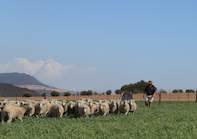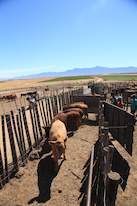
Instead of using restraints, noise, whips or sticks, low stress livestock handling uses animal’s natural instincts to manage livestock, such as sheep, cattle and horses. The animals, in effect, are moved in a calm quiet way, causing the animals to get less excited and agitated, resulting in less stress and fewer injuries to animals and handlers.
Low stress livestock handling is not a new thing, but good livestock handlers have traditionally been seen as “miracle workers” until Bud Williams, a cattle handling expert from Canada, and Dr Temple Grandin, an animal behaviour expert, started analysing their intuitive and instinctive actions to explain and teach others how it works from the late ninety-eighties.
This article is a mere summary of the basic principles on which low stress livestock handling is based and not an in-depth explanation.
Field of Vision
Because their eyes are located on the sides of their heads, livestock have wide angle vision. According to Dr Grandin, cattle and pigs have a visual field in excess of 300 degrees, while those of sheep ranges from 191 to 306 degrees, depending on the amount of wool on the head.
While having a wide range of vision, these animals have a blind spot. For a cow this spot is situated directly behind her, in the area between the hips. Entering this blind spot, will cause the animal to stop and turn to see what you are doing.
Point of Balance
Low stress livestock handlers make use of what they call an animal’s point of balance and flight zone to move animals. The point of balance is situated at the shoulders for most livestock. The animal will move forward if the handler stands behind the point of balance and backward when the handler is ahead of the point of balance.
Flight Zone

An animal’s flight zone is its personal space. Entering it will cause an animal to move away to get distance from the intruder. Moving in too fast into the flight zone, continued pressure or the cornering of the animal, may however cause the animal to attack the intruder or run.
According to the Canadian Centre for Health and Safety in Agriculture, the edge of the flight zone can be located by moving towards the animal. The animal will raise its head and turn to you at the edge of the flight zone, but start moving once you are in the flight zone. The size of the flight zone differs from one animal to another and can be diminished with frequent handling.
Read more about how low stress livestock handling makes use of animal instincts.